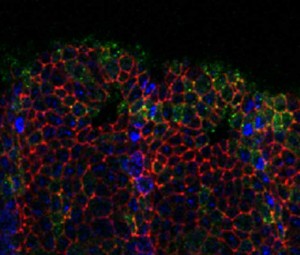Kia Perez-Vale (2015-2021) Genetics and Molecular Biology
Current Position
Postdoc in Ben Sanger’s lab at the University of Pennsylvania
Education: Graduate Student, Peifer lab (2015-2021), BS, University of Puerto Rico-Arecibo 2014; UNC PREP 2014-2015
Fellowships & Awards: NIH F31 Graduate Fellowship; NIH T32 Training Program in Genetics and Molecular Biology
During embryonic development, cells need to multiply, differentiate, change shape, and move to ultimately create our body architecture. A key question that drives my dissertation work is: how can epithelial cells change shape and move while maintaining their organization and integrity? Proper tissue organization requires the cell-cell adherens junctions (AJ) to be connected to the actomyosin cytoskeleton, as well as cell polarity establishment and maintenance. I investigated the role and mechanism of action of Canoe, a multidomain protein that acts as an AJ-cytoskeletal linker, during Drosophila development. The overarching theme emerging from my work is that the machinery mediating AJ-cytoskeleton linkage and apical-basal polarity establishment does not form a simple linear pathway. Instead, a complex multivalent network of protein, in which each interaction has different degrees of importance, with some essential while other dispensable, is involved.
First, I investigated how the small GTPase Rap1 regulates Canoe during apical-basal polarity establishment. I found that Canoe’s cortical localization during polarity establishment is regulated by active Rap1, which binds Canoe’s RA domains. Strikingly, Canoe’s RA domains are dispensable for membrane localization, but critical for apical restriction and tricellular junction (TCJ) enrichment. Dizzy, a Rap1 activator, is essential for Canoe’s TCJ enrichment. Second, I investigated how Canoe works as an AJ-cytoskeletal linker ensuring tissue robustness under mechanical tension. Our data revealed that during germband elongation and dorsal closure Canoe reinforces junctions under tension and in its absence Polychaetoid plays a parallel role. Embryos lacking both Canoe and Polychaetoid have early junctional failure leads to loss of tissue integrity. Third, I began to define how Canoe works as a machine, beginning in a situation where the functions of Canoe’s multiple domains were largely unexplored in vivo. I discovered that Canoe’s PDZ and F-actin binding domains are dispensable for viability, and for Canoe AJ localization and TCJ enrichment. The F-actin binding domain reinforces junction under mechanical tension. However, Canoe’s RA domains are important for its TCJ and vertical border enrichment during planar polarity, which are areas of high tension. My work reinforces the idea that multiple inputs ensure tissue integrity during development. Finally, I worked with Kristi Yow to explore how Canoe’s upstream activator, the small GTPas Rap1, functions during embryonic morphogenesis. Rap1 uses Canoe as one effector, regulating junctional planar polarity. However, Rap1 has additional roles in junctional protein localization and balanced apical constriction-in its absence, Bazooka/Par3 localization is fragmented, and cells next to mitotic cells apically constrict and invaginate, disrupting epidermal integrity. In contrast, the GEF Dizzy has phenotypes similar to but slightly less severe than Canoe loss, suggesting that this GEF regulates Rap1 action via Canoe. Taken together, these data reveal that Rap1 is a crucial regulator of morphogenesis, likely acting in parallel via Canoe and other effectors, and that different Rap1 GEFs regulate distinct functions of Rap1.
Publications
Perez-Vale, KZ., Yow, K,D., Johnson, R, I,. Byrnes, A.E., Finegan, T.M., Slep, K.C., and Peifer, M. (2021) Multivalent interactions make adherens junction-cytoskeletal linkage robust during morphogenesis. Journal of Cell Biology 220:e202104087..
Perez-Vale, K.Z, and Peifer, M. (2020). Orchestrating morphogenesis: building the body plan by cell shape changes and movements. Development 147, dev191049.
Manning, L.A., Perez-Vale, K.Z., Schaefer, K.N., Sewell, M.T., Peifer, M. (2019). The Drosophila Afadin and ZO-1 homologs Canoe and Polychaetoid act in parallel to maintain epithelial integrity when challenged by adherens junction remodeling. Molecular Biology of the Cell 30,1938-1960.
Perez-Vale, K.Z., and Peifer, M. (2018). Modulating Apical-Basal Polarity by Building and Deconstructing a Yurt. Journal of Cell Biology 217,3772-3773.
Bonello, T.T., Perez-Vale, K.Z., Sumigray, K.D., and Peifer, M. (2018) Rap1 acts via multiple mechanisms to position Canoe/Afadin and adherens junctions and mediate apical-basal polarity establishment. .
Kristi Schaefer (2013-2018) Genetics and Molecular Biology
Current Position: Postdoc, Shaw lab, Indiana University
Graduate Student (2013 – 2018)
Education: Graduate Student, Peifer lab (2013 – 2018), BS, Biology, Butler University 2008; Lab Tech IU School of Medicine-Dept. of Medical and Molecular Genetics 2009-2012
Fellowships & Awards: NIH Training Program in Genetics and Molecular Biology
NSF Graduate Fellowship (2014-2016)
Email: krihertz@iu.edu
DOWNLOAD CV
Research Information
According to the American Cancer Society, there will be 102,000 new cases of colon cancer this year. The tumor suppressor APC is the initiating mutation in 80% of all colon cancers. APC, along with Axin (a scaffolding protein) and the kinases CK1 and GSK3, form the destruction complex that regulates levels of β-Catenin (βCat), the key effecter of the Wnt signaling pathway which modulates proliferation and cell cycle. When Wnt signaling is off, the destruction complex phosphorylates βCat, labeling it to be targeted for destruction by the E3 ligase complex SCF, containing the F-box protein βTrCP. The mechanism of how the destruction complex transfers βCat to the E3 ligase is largely unknown. Recently the lab discovered that the scaffolding protein Axin has a conserved βTrCP binding motif and that βTrCP and Axin co-localize in human cells. I am trying to determine the mechanism and function of βTrCP-Axin interactions. To tease out this mechanism I am utilizing both mammalian cell culture and Drosophila genetics and cell biology.
Publications
- Schaefer, K.N., Pronobis, M., Williams, C.E., Zhang, S., Bauer, L., Goldfarb, D., Yan, F., Major, M.B., Peifer, M. (2020). Wnt Regulation: Exploring Axin-Disheveled interactions and defining mechanisms by which the SCF E3 ubiquitin ligase is recruited to the destruction complex. Molecular Biology of the Cell 31, 992-1014.
- Schaefer, K.N., and Peifer M. (2019). Wnt/Beta-catenin signaling regulation and a role for biomolecular condensates. Developmental Cell48: 429-44.
- Manning, L.A., Perez-Vale, K.Z., Schaefer, K.N., Sewell, M.T., Peifer, M. (2019). The Drosophila Afadin and ZO-1 homologs Canoe and Polychaetoid act in parallel to maintain epithelial integrity when challenged by adherens junction remodeling. Molecular Biology of the Cell, in press.
- Schaefer, K.N., Bonello, T.T., Zhang, S., Williams, C.E., Roberts, D.M., McKay, D.J, and Peifer, M. (2018). Supramolecular assembly of the beta-catenin destruction complex and the effect of Wnt signaling on its localization, molecular size, and activity in vivo. PLoS Genetics doi.org/10.1371/journal.pgen.1007339.
- Fadero, T.C., Gerbich, T.M. , Rana, K., Suzuki, A. DiSalvo, M., Schaefer, K.N., Heppert, J.K., Boothby, T.C, Goldstein, B., Peifer, M., Allbritton, N.L., Gladfelter, A.S., Maddox, A.S. and Maddox, P.S. (2018). LITE microscopy: Tilted light sheet excitation of model organisms offers high resolution and low photobleaching. Journal of Cell Biology, in press.
- Rogers, E.M., Spracklen, A.J., Bilancia, C.G., Sumigray, K.D., Allred, S.C., Nowotarski, S.N., Schaefer, K. N., Ritchie, B.J., and Peifer, M. (2016). Abelson kinase acts as a robust, multifunctional scaffold in regulating embryonic morphogenesis. Molecular Biology of the Cell 27, 2613-31.
-
Targeting of Ras-mediated FGF signaling suppresses Pten-deficient skin tumor. Mathew G, Hannan A, Hertzler-Schaefer K, Wang F, Feng GS, Zhong J, Zhao JJ, Downward J, Zhang X. Proc Natl Acad Sci U S A. 2016 Nov 15;113(46):13156-13161
- Hertzler-Schaefer K, Mathew G, Somani AK, Tholpady S, Kadakia MP, Chen Y, Spandau DF, Zhang X. (2014) Pten loss induces autocrine FGF signaling to promote skin tumorigenesis. Cell Reports 6(5):818-26. doi: 10.1016/j.celrep.2014.01.045.
- Carbe C, Hertzler-Schaefer K, Zhang, X. (2012) The functional role of the Meis/Prep-binding elements in Pax6 locus during pancreas and eye development. Developmental Biology 363:320-329
- Qu X, Hertzler K, Pan Y, Grobe K, Robinson ML, Zhang X. (2011) Genetic epistasis between heparin sulfate and FGF-Ras signaling controls lens development. Developmental Biology 355:12-20






